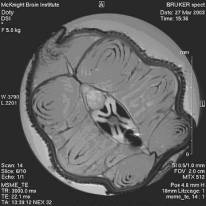Research
Future Technology at Doty Scientific
For the latest updates and a chronological log of our major R&D developments of the past several years, please see “What’s New“.
Solids NMR
Doty Scientific began 29 years ago because an MAS probe that could easily spin a sample at 5 kHz was needed for NMR of solids but was not available. Much of our instrument development for NMR of solids was directed by customers in that way. However, sometimes the innovations were Doty driven – things like the Doty XC probes that permit highest performance H/X/Y MAS in large samples at the highest fields.
But you came to this page to see where we are going, not where we have been. We invite you to take a look at our progress on our new SAS (switched angle spinner) probes and our Cryo-MAS project, both of which have been partially supported by NIH SBIR grants.
Sample heating from rf decoupling currently imposes serious limitations on MAS of biological solids. We have always known that our two-coil XC (cross coil) MAS probes offer superior S/N and very low decoupler heating with excellent B1 matching on all channels. In 2004, we better quantified the performance at 750 MHz. The performance even surprised us, and more improvements are coming soon. To learn more, please visit the page on the 750 MHz XC4 Triple-Resonance MAS Results.
A resurgence in interest in Switched Angle Spinning (SAS) has been spurred by recent analyses and experiments that indicate novel SAS techniques should provide useful dynamic control over bicelle alignment. The XC7 WB SAS probe has unprecedented switching time, resolution, and robustness. We are developing a new narrow-bore SAS probe. To learn more about the research concerning this new probe, download a copy of a presented technical poster on SAS probe developments, ENC 2006
MRI
Those familiar with Doty Scientific, Inc. know that Doty’s linear rf Litz coils offer higher S/N, better homogeneity, and much greater tuning flexibility than was considered achievable before their introduction in 1997 for a wide range of small-animal imaging applications (especially double-resonance) at fields up to 500 MHz.
In 2002, we introduced our circular polarization Litzcage coils, which represent the ultimate in robust, easy-to-use, fully optimized rf coils for single resonance MRI at very high fields. These coils are being used in numerous small animal platforms and modules and developments in progress are expected to further improve their performance in the near future, as well as permit more options for double-tuning. The first of our new, passive, 3T head Litzcage coils has been tested and has demonstrated unmatched performance. In 2004, we completed a smaller diameter 3 T litzcage head coil designed for imaging in the Siemens Allegra imager. We are also quite proud of our new Double-tuned 1H/31P 3T Homogeneous CP Head Coil with Improved Usability (technical poster presented at ISMRM 2005). Both of these new coils are now at test sites. For more information, please visit the page on Head RF Coils. We developed a plug-compatible interface unit providing two ultra-low-noise quadrature preamps and ultra-low-loss T/R switch/hybrid circuitry. This allows lower-cost passive coils to be used with Siemens systems designed for active coils and will enhance the S/N in other cases.
For many years, Doty Scientific has supplied vertical-bore imaging probes with high-strength gradients and highest-performance rf coils. In 2003, we delivered a vertical-bore probe that re-defines “quantum leap” in technology. To our knowledge, prior circular-polarization (CP) coils have not been successful above 500 MHz for samples larger than 5 mm. We demonstrated unprecedented 50-micron resolution in a robust, 21 mm CP Litzcage at 750 MHz .
Baby Shark 21mm CP litzcage at 750MHz
Energy
Most of our NMR and MRI customers are surprised to learn that energy-related R&D has been a small but important component of the research at Doty Scientific from the beginning. Our focus has been primarily on novel concepts and designs for small, efficient microturbines. Recently, we have come to accept that the diesel engine has won, and it is time to bow out gracefully – well, sorta. We have also come to realize how confused, or at least misdirected, much of the rest of futuristic energy research has become over the past six years, and we would like to offer an unbiased, scientific perspective on renewables and hydrogen.
Check out our energy work. http://www.DotyEnergy.com


